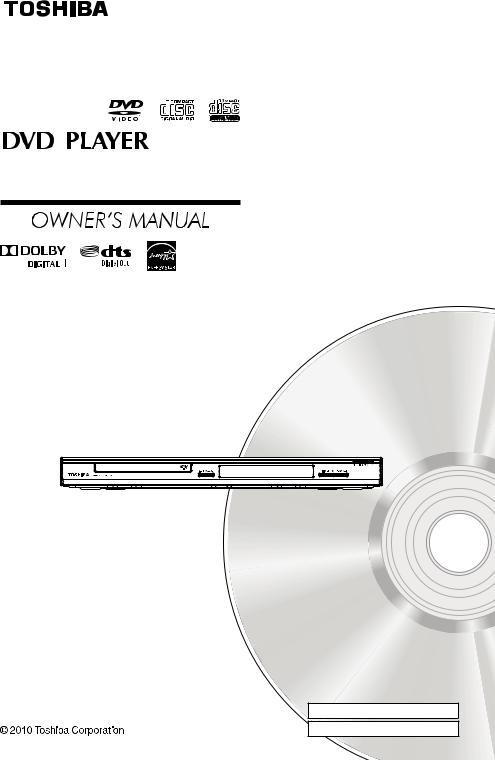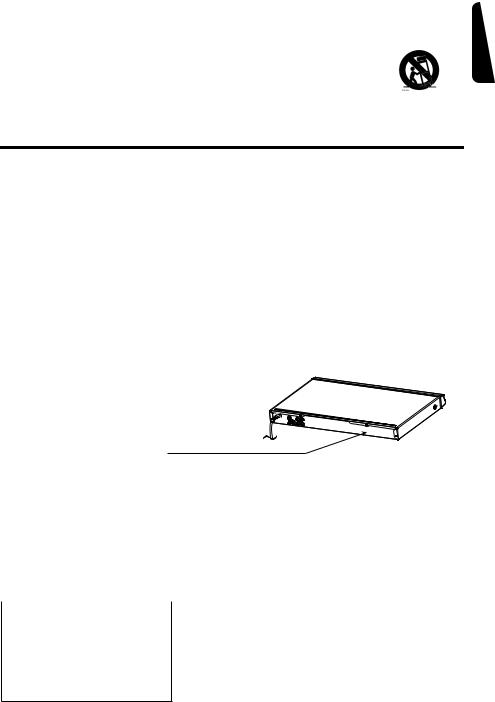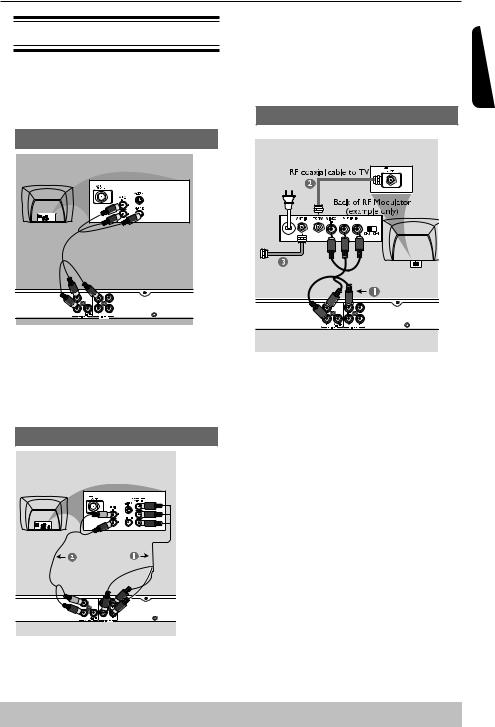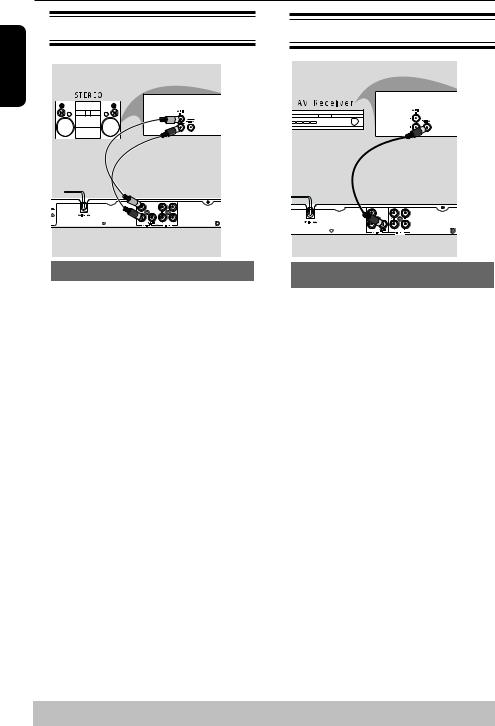Toshiba SD4300KU, SD4300 User Manual

SD4300KU
Owner’s Record
The model number and serial number are on the back of your DVD Player. Record these numbers in the spaces below Refer to these numbers whenever you communicate with your Toshiba dealer about this DVD Player.
Model number:
Serial number:

English
Introduction
SAFETY PRECAUTIONS
CAUTION: VISIBLE LASER RADIATION WHEN OPEN. DO NOT STARE INTO BEAM.
The lightning flash with arrowhead symbol, within an equilateral triangle, is intended to alert the user to the presence of uninsulated 'dangerous voltage' within the product' s enclosure that may be of sufficient magnitude to constitute a risk of electric shock to persons.
The exclamation point within an equilateral triangle is intended to alert the user to the presence of important operating and maintenance (servicing) instructions in the literature accompanying the appliance.
The symbol for CLASS II (Double Insulation)
ENERGY STAR® qualified DVD. Products that earn the ENERGY STAR prevent green house gas emissions by meeting strict energy efficiency guidelines set by the U.S. Environmental Protection Agency and the U.S. Department of Energy. ENERGY STAR and the ENERGY STAR mark are registered U.S. marks.
WARNING:
TO REDUCE THE RISK OF FIRE OR ELECTRIC SHOCK, DO NOT EXPOSE THIS APPLIANCE TO RAIN OR MOISTURE. DANGEROUS HIGH VOLTAGES ARE PRESENT INSIDE THE ENCLOSURE. DO NOT OPEN THE CABINET. REFER SERVICING TO QUALIFIED PERSONNEL ONLY.
CAUTION:
TO PREVENT ELECTRIC SHOCK, MATCH WIDE BLADE OF PLUG TO WIDE SLOT, FULLY INSERT.
ATTENTION:
POUR EVITER LES CHOCS ELECTRIQUES, INTRODUIRE LA LAME LA PLUS LARGE DE LA FICHE DANS LA BORNE CORRESPONDANTE DE LA PRISE ET POUSSER JUSQU'AU FOND.
CAUTION:
PLEASE READ AND OBSERVE ALL WARNINGS AND INSTRUCTIONS GIVEN IN THIS OWNER' S MANUAL AND THOSE MARKED ON THE UNIT. RETAIN THIS BOOKLET FOR FUTURE REFERENCE.
CAUTION:
USE OF ANY CONTROLS, ADJUSTMENTS, OR PROCEDURES OTHER THAN THOSE SPECIFIED HEREIN MAY RESULT IN HAZARDOUS RADIATION EXPOSURE.
FCC NOTICE:
This equipment has been tested and found to comply with the limits for a Class B digital device, pursuant to part 15 of the FCC Rule.
These limits are designed to provide reasonable protection against harmful interference in a residential installation. This equipment generates, uses, and can radiate radio frequency energy and, if not installed and used in accordance with the instructions, may cause harmful interference to radio communications.
However, there is no guarantee that interference will not occur in a particular installation.
If this equipment does cause harmful interference to radio or television reception, which can be determined by turning the equipment off and on, the user is encouraged to try to correct the interference by one or more of the following measures:
-Reorient or relocate the receiving antenna.
-Increase the separation between the equipment and receiver.
-Connect the equipment into an outlet on a circuit different from that to which the receiver is connected.
-Consult the dealer or an experienced radio/TV technician for help.
Changes or modifications made to this equipment, not expressly approved by Toshiba, or parties authorized by Toshiba, could void the user' s authority to operate the equipment.
IMPORTANT SAFETY INSTRUCTIONS
1.Read these instructions.
2.Keep these instructions.
3.Heed all warnings.
4.Follow all instructions.
5.Do not use this apparatus near water.
6.Clean only with dry cloth.
7.Do not block any ventilation openings. Install in accordance with the manufacturer’s instructions.
8.Do not install near any heat sources such as radiators, heat registers, stoves, or other apparatus (including amplifiers) that produce heat.

|
Introduction |
|
|
9. |
Do not defeat the safety purpose of the polarized or grounding-type plug. A polarized plug has two blades with one |
|
|
|
wider than the other. A grounding type plug has two blades and a third grounding prong. The wide blade or the third |
|
|
|
prong are provided for your safety. If the provided plug does not fit into your outlet, consult an electrician for |
English |
|
|
replacement of the obsolete outlet. |
||
10. |
Protect the power cord from being walked on or pinched particularly at plugs, convenience receptacles, and the |
||
|
point where they exit from the apparatus. |
||
11. |
Only use attachments/accessories specified by the manufacturer. |
||
12. |
Use only with the cart, stand, tripod, bracket, or table specified by the manufacturer, or sold with |
|
|
|
the apparatus. When a cart is used, use caution when moving the cart/apparatus combination |
|
|
|
to avoid injury from tip-over. |
|
|
13. |
Unplug this apparatus during lightning storms or when unused for long periods of time. |
|
|
14. |
Refer all servicing to qualified service personnel. Servicing is required when the apparatus has been damaged in |
|
|
|
any way, such as power-supply cord or plug is damaged, liquid has been spilled or objects have fallen into the |
|
|
|
apparatus, the apparatus has been exposed to rain or moisture, does not operate normally, or has been dropped. |
|
|
Additional Safety Instructions
15.Do not overload wall outlets; extension cords, or integral convenience receptacles as this can result in a risk of fire or electric shock.
16.Apparatus shall not be exposed to dripping or splashing and no objects filled with liquids, such as vases, shall be placed on the apparatus.
17.Keep your fingers well clear of the disc tray as it is closing. Neglecting to do so may cause serious personal injury.
18.Do not place a heavy object on or step on the apparatus. The object may fall, causing serious personal injury and serious damage to the apparatus.
19.Do not use a cracked , deformed, or repaired disc. These discs are easily broken and may cause serious personal injury and apparatus malfunction.
20.If the apparatus should smoke or smell,immediately disconnect the power cord from the wall outlet. Wait until the smoke or smell stops, then ask your dealer for a check and repair. Neglecting to do so may cause fire.
21.While it is thundering, do not touch the connecting cables or the apparatus.
22.Warning: To prevent the spread of fire, keep candles or other open flames away from this product at all times.
CAUTION:
This Digital Video Disc Player employs a Laser System.
To ensure proper use of this product, please read this owner’s manual carefully and retain for future reference Should the unit require maintenance, contact an authorized service location.
Use of controls or adjustments or performance of procedures other than those specified herein may result in hazardous radiation exposure.
To prevent direct exposure to laser beam, do not try to open the enclosure. Visible and invisible laser radiation when open and interlocks defeated.
DO NOT STARE INTO BEAM.
Location of the required label:
CERTIFICATION:This product complies
with FDA Rule 21 CFR Subchapter J in effect at date of manufacture.
CAUTION: These servicing instructions are for use by qualified service personnel only. To reduce the risk of electric shock do not perform any servicing other than that contained in the operating instructions unless you are qualified to do so.
Be aware that this equipment is still powered when in standby mode. To disconnect this equipment completely from the mains power, pull out the power plug from the wall outlet.
The mains plug is used as the disconnect device, the disconnect device shall remain readily operable.
Environmental Information
All unnecessary packaging has been omitted. The packaging has been made easy to separate into three materials; cardboard (box), polystyrene foam (buffer) and polyethylene (bags, protective foam sheet).
Your DVD player consists of materials which can be recycled and reused if disassembled by a specialised company. Please observe the local regulations regarding the disposal of packaging materials, exhausted batteries and old equipment.
LASER |
|
Type |
Semiconductor laser |
|
InGaAIP(DVD) |
|
AIGaAs(CD) |
Wave length |
657 nm(DVD) |
|
790 nm(CD) |
Output Power |
5.5 mW(DVD) |
|
7.0 mW(VCD/CD) |
Beam divergence 60 degrees

English
Introduction
WARNING:
RISK OF ELECTRIC SHOCK!
Never attempt to service this product yourself. Opening and removing the covers may expose you to dangerous voltage or other hazards. Failure to follow this WARNING may result in death or serious injury. Refer all servicing not specified in this manual to a Toshiba Authorized Service Center.
CAUTION!
Do not use solvents such as benzene, thinner, commercially available cleaners, or anti-static sprays intended for analog discs. Since the optical unit (laser) of the DVD system operates at a higher power than regular DVD or CD players, cleaning CDs intended for DVD or CD players may damage the optical unit (laser). Therefore, refrain from using a cleaning CD.
Setup
Finding a suitable location
-Place the set on a flat, hard and stable surface. -Do not place the set on a carpet.
-Do not position the set on top of other equipment that might heat it up (e.g., receiver or amplifier). -Do not put anything under the set
(e.g.CDs, magazines).
-Install this unit near the AC outlet and where the AC power plug can be reached easily.
Space for ventilation
-Place the apparatus in a location with adequate ventilation to prevent internal heat build up. Allow at least 10 cm (4.0'') clearance from the rear and the top of the set and 5 cm (2.0'') from the left and right to prevent overheating.
5cm (2.0")
10cm (4.0") |
10cm (4.0") |
5cm (2.0")
Avoid high temperatures, moisture, water and dust
-Apparatus shall not be exposed to dripping or splashing.
-Do not place any sources of danger on the apparatus (e.g., liquid filled objects, lighted candles).
Cleaning discs
Some problems occur because the disc inside the system is dirty (frozen picture, sound disruptions, picture distortions). To avoid these problems, discs should be cleaned on a regular basis.
To clean a disc, use a micro fibre cleaning cloth and wipe the disc from the center to the edge in a straight line. Do not touch the playback side of the disc.
Moisture Condensation
Moisture condensation damages the DVD player. Please read the following carefully. Moisture condensation occurs, for example, when you pour a cold drink into a glass on a warm day. Drops of water form on the outside of the glass. In the same way, moisture may condense on the optical pick-up lens inside this unit, one of the most crucial internal parts of the DVD player.
If you use the DVD player in such a situation, it may damage discs and internal parts. Remove the disc, connect the power cord of the DVD player to the wall outlet, turn on the DVD player, and leave it for two or three hours. After two or three hours, the DVD player will have warmed up and evaporated any moisture. Keep the DVD player connected to the wall outlet and moisture condensation will seldom occur.
Region Codes
This DVD player is designed to support the Region Management System. Check the regional code number on the disc package. If the number does not match the player' s region number (see table on page 4), the player may be unable to playback the disc.
Tips:
-It may not be possible to play CD-R/RW , DVD+R/ RW , or DVD+R DL in all cases due to the type of disc or condition of the recording.
-If you are having trouble playing a certain disc, remove the disc and try a different one. Improperly formatted disc will not play on this DVD Player.

Region |
Discs that can |
||
|
be played |
||
U.S.A. and |
ALL |
1 |
|
Canada regions |
|||
U.K., |
|
2 |
|
Europe regions and |
ALL |
||
Japan |
|||
|
|
||
Asia Pacific, |
|
|
|
Taiwan, Korea |
ALL |
3 |
|
|
|||
Australia, |
|
|
|
New Zealand, |
ALL |
4 |
|
Latin America |
|||
Russia and |
ALL |
5 |
|
India regions |
|||
China, Calcos Islands, |
ALL |
6 |
|
Walls and Futuna |
|||
Islands |
|
|
|
This product incorporates copyright protection technology that is protected by method claims of certain U.S. patents and other intellectual property rights owned by Macrovision Corporation and other rights owners. Use of this copyright protection technology must be authorized by Macrovision Corporation, and is intended for home and other limited viewing uses only unless otherwise authorized by Macrovision Corporation. Reverse engineering or disassembly is prohibited.
Notes on copyright
The unauthorized recording, use, distribution, or revision of television programs, videotapes, DVDs and other materials, is prohibited under the Copyright Laws of the United States and other countries, and may subject you to civil and/or criminal liability.
Introduction
English

English
Introduction
Table of Contents
Introduction
SAFETY PRECAUTIONS IMPORTANT SAFETY INSTRUCTIONS Setup
Cleaning discs Moisture Condensation Region Codes
Table of Contents
Connections
Connecting to television
Connecting to a Stereo System
Connecting to a Digital AV Receiver
Connecting the power cord
Product Overview
Front and Rear panels
Remote Control
Getting Started
Inserting Batteries
Finding your viewing channel Setting up Progressive Scan feature Setting the language
. Playback from Disc
Playable discs
Playback Feature
Starting disc playback Basic playback control
Operations for video playback (DVD/VCD/SVCD) Selecting various repeat functions
Viewing the disc playback Information Special DVD Features
Special VCD and SVCD Features Playing MP3/JPEG/Kodak picture CD
DVD Menu Options
Using the Language setup menu Using the Video setup menu Using the Audio setup menu Using the Rating setup menu
Using the Misc (Miscellaneous) setup menu Tray Lock
Others
Specifications
Troubleshooting
Glossary
Limited United States Warranty
Canadian Warranty Information
1
1-2
3
3
3
3-4
5
6
7
7
8
9
10
11
11
11-12
12
12-13
13
13-14
14
14-15
15
15
15
16-17
17
17-18
18-19
19-20
20
20
21
22-23
24
25
26-27

Connections
Connecting to television
IMPORTANT!
–You only need to make one video connection from the following options, depending on the capabilities of your television.
–Connect the DVD player directly to the television.
Using Composite Video Jack(CVBS)
AUse the composite video cable (yellow) to connect the DVD player' s VIDEO(CVBS) jack to the video input jack(or labeled as A/V in, Video In or Composite) on the TV(cable supplied).
To hear the sound of this DVD player through your TV, use the audio cables(white/red)to connect AUDIO OUT(L/R)jacks of the DVD player to corresponding AUDIO IN jacks on the TV(cable supplied).
Using Component Video Jacks(Y, PB, PR)
IMPORTANT!
-The progressive scan video quality is only possible when using Y, PB, PR and a progressive scan TV is required.
AUse the component video cables (red/blue/green) to connect the DVD player' s Y, PB, PR jacks to the
corresponding Component video input jacks (or labeled as Y, Pb, Pr) on the TV (cable not supplied).
BUse the audio cables (white/red) to connect AUDIO OUT (L/R) jacks of the DVD player to the corresponding AUDIO IN jacks on the TV (cable not supplied).
CProceed to page 11 for detailed Progressive Scan set up.
Using a RF modulator
IMPORTANT!
-If your TV only has a single Antenna In jack (or labeled as 75 ohm or RF In), you will need an RF modulator in order to view the DVD playback on the TV.
AUse the composite video cable (yellow) to connect the DVD player' s VIDEO (CVBS) jack to the video input jack on the RF modulator (cable supplied).
To hear the sound of this DVD player through your TV, use the audio cables(white/red) to connect AUDIO OUT (L/R) jacks of the DVD player to the corresponding AUDIO IN jacks on the RF modulator (cable supplied).
BUse the RF coaxial cable (not supplied) to connect ANTENNA OUT or TO TV jack on the RF modulator to the ANTENNA IN jack on the television.
CConnect the Antenna or Cable TV service signal to the ANTENNA IN or RF IN jack on the RF modulator. (It may have been connected to your TV previously. Disconnect it from the TV.)
Helpful hint: Before making or changing any connections, make sure that all the devices are disconnected from the power outlet.
English

Connections
Connecting to a Stereo System |
Connecting to a Digital AV Receiver |
English
Stereo System with Left/Right Audio In Jacks
ASelect one of the video connections (CVBS VIDEO IN or COMPONENT VIDEO IN)
depending on the options available on your TV.
BUse the audio cables (white/red) to connect AUDIO OUT (L/R) jacks of the DVD Player to the corresponding AUDIO IN jacks on the stereo system.
Receiver has a PCM, Dolby Digital or MPEG decoder
ASelect one of the video connections (CVBS VIDEO IN or COMPONENT VIDEO IN)
depending on the options available on your TV.
BConnect the COAXIAL jack of the DVD player to the corresponding Digital Audio In jack on your Receiver (cable not supplied).
CSet the DVD Player' s Digital Output to PCM or All depending on the capabilities of your Receiver (see page 19 {Digital Output}).
Tip:
-If the audio format of the Digital Output does not match the capabilities of your receiver, the receiver will produce a strong, distorted sound or no sound at all.
Helpful hint: Before making or changing any connections, make sure that all the devices are disconnected from the power outlet.

Connections
Connecting the power cord
English
After everything is connected properly, plug in the AC power cord to the power outlet.
Never make or change any connections with the power switched on.
Helpful hint: Before making or changing any connections, make sure that all the devices are disconnected from the power outlet.
